Exploring Nation, Power, and Difference in Australian Context
VerifiedAdded on 2020/05/01
|9
|2147
|191
Report
AI Summary
This report analyzes the concepts of nation, power, and difference within the context of Australia, examining the historical and contemporary issues of racism and inequality. The report reviews four online posts discussing whiteness, privilege, and the marginalization of non-white individuals in Australia. It highlights contradictions and complexities within the posts, particularly regarding the relationship between white privilege and the denial of problems faced by other races. The analysis connects these issues to the core concepts of nation, power, and difference, emphasizing the historical context of the White Australia Policy and the evolving multicultural landscape. The report discusses the sharing of power, the need for equality, and the importance of recognizing the rights of indigenous Australians. It concludes by emphasizing the ongoing efforts to integrate all races into Australian society, while acknowledging the work that remains to be done to achieve true equality and justice. The report uses various sources including ABC News, Australia.gov.au, and academic papers to support its arguments.
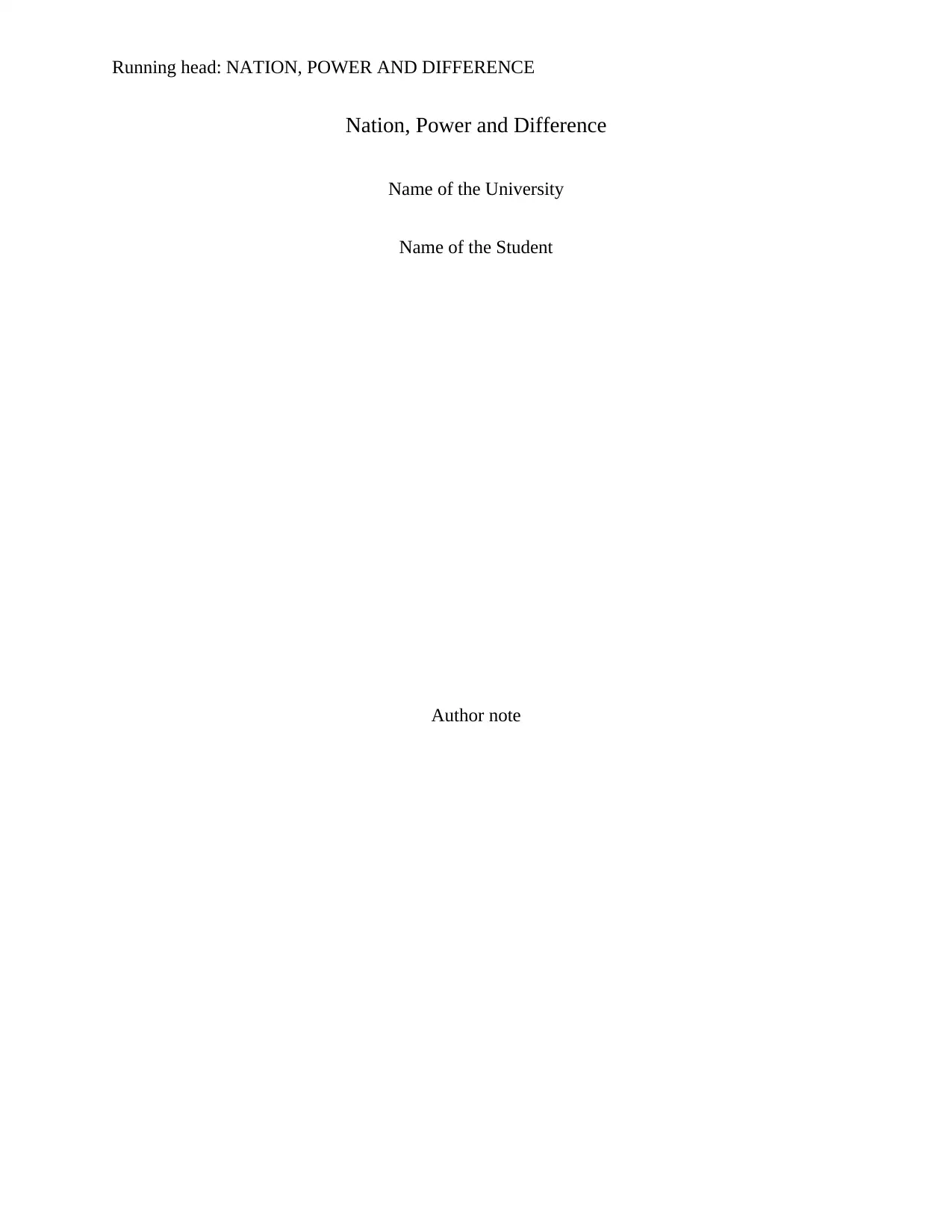
Running head: NATION, POWER AND DIFFERENCE
Nation, Power and Difference
Name of the University
Name of the Student
Author note
Nation, Power and Difference
Name of the University
Name of the Student
Author note
Paraphrase This Document
Need a fresh take? Get an instant paraphrase of this document with our AI Paraphraser
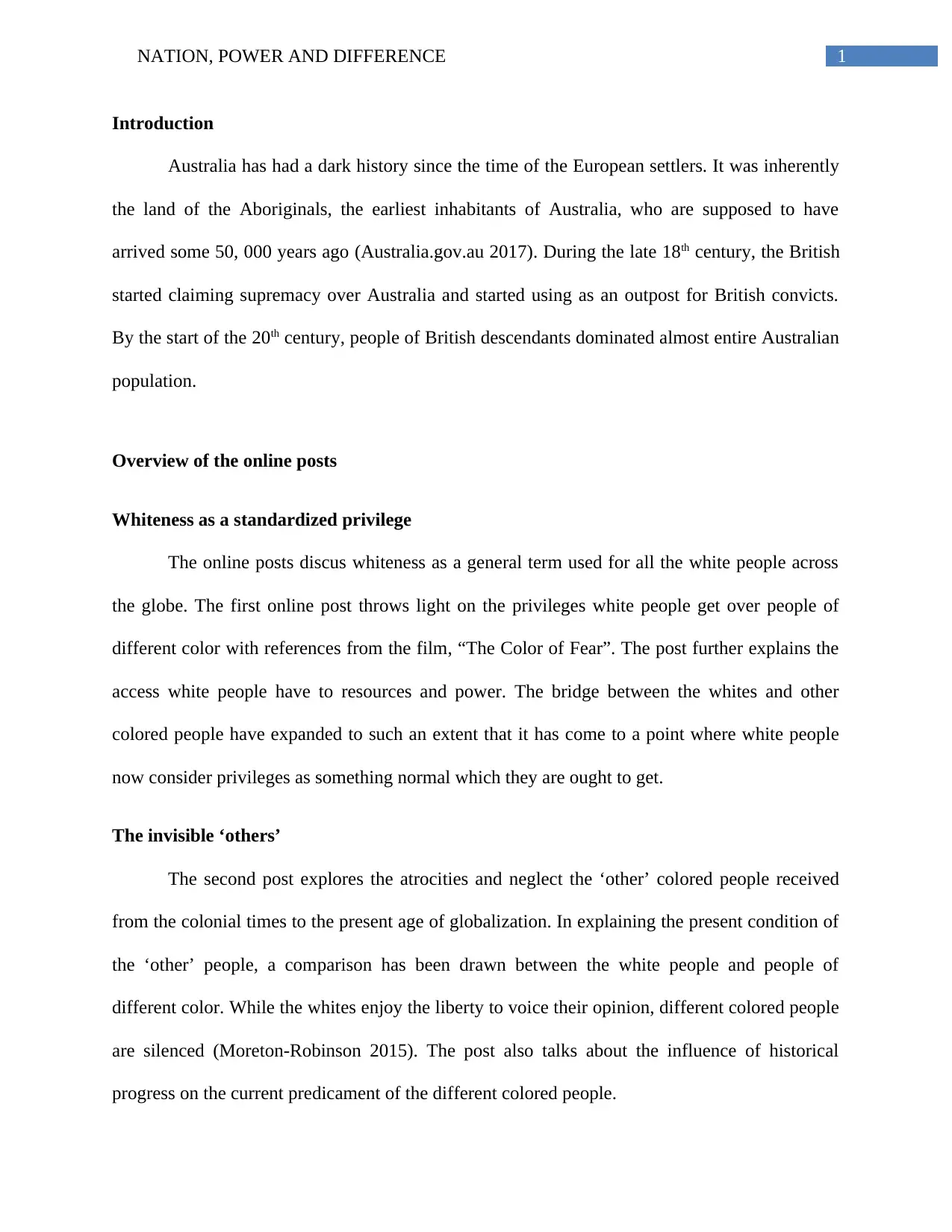
1NATION, POWER AND DIFFERENCE
Introduction
Australia has had a dark history since the time of the European settlers. It was inherently
the land of the Aboriginals, the earliest inhabitants of Australia, who are supposed to have
arrived some 50, 000 years ago (Australia.gov.au 2017). During the late 18th century, the British
started claiming supremacy over Australia and started using as an outpost for British convicts.
By the start of the 20th century, people of British descendants dominated almost entire Australian
population.
Overview of the online posts
Whiteness as a standardized privilege
The online posts discus whiteness as a general term used for all the white people across
the globe. The first online post throws light on the privileges white people get over people of
different color with references from the film, “The Color of Fear”. The post further explains the
access white people have to resources and power. The bridge between the whites and other
colored people have expanded to such an extent that it has come to a point where white people
now consider privileges as something normal which they are ought to get.
The invisible ‘others’
The second post explores the atrocities and neglect the ‘other’ colored people received
from the colonial times to the present age of globalization. In explaining the present condition of
the ‘other’ people, a comparison has been drawn between the white people and people of
different color. While the whites enjoy the liberty to voice their opinion, different colored people
are silenced (Moreton-Robinson 2015). The post also talks about the influence of historical
progress on the current predicament of the different colored people.
Introduction
Australia has had a dark history since the time of the European settlers. It was inherently
the land of the Aboriginals, the earliest inhabitants of Australia, who are supposed to have
arrived some 50, 000 years ago (Australia.gov.au 2017). During the late 18th century, the British
started claiming supremacy over Australia and started using as an outpost for British convicts.
By the start of the 20th century, people of British descendants dominated almost entire Australian
population.
Overview of the online posts
Whiteness as a standardized privilege
The online posts discus whiteness as a general term used for all the white people across
the globe. The first online post throws light on the privileges white people get over people of
different color with references from the film, “The Color of Fear”. The post further explains the
access white people have to resources and power. The bridge between the whites and other
colored people have expanded to such an extent that it has come to a point where white people
now consider privileges as something normal which they are ought to get.
The invisible ‘others’
The second post explores the atrocities and neglect the ‘other’ colored people received
from the colonial times to the present age of globalization. In explaining the present condition of
the ‘other’ people, a comparison has been drawn between the white people and people of
different color. While the whites enjoy the liberty to voice their opinion, different colored people
are silenced (Moreton-Robinson 2015). The post also talks about the influence of historical
progress on the current predicament of the different colored people.
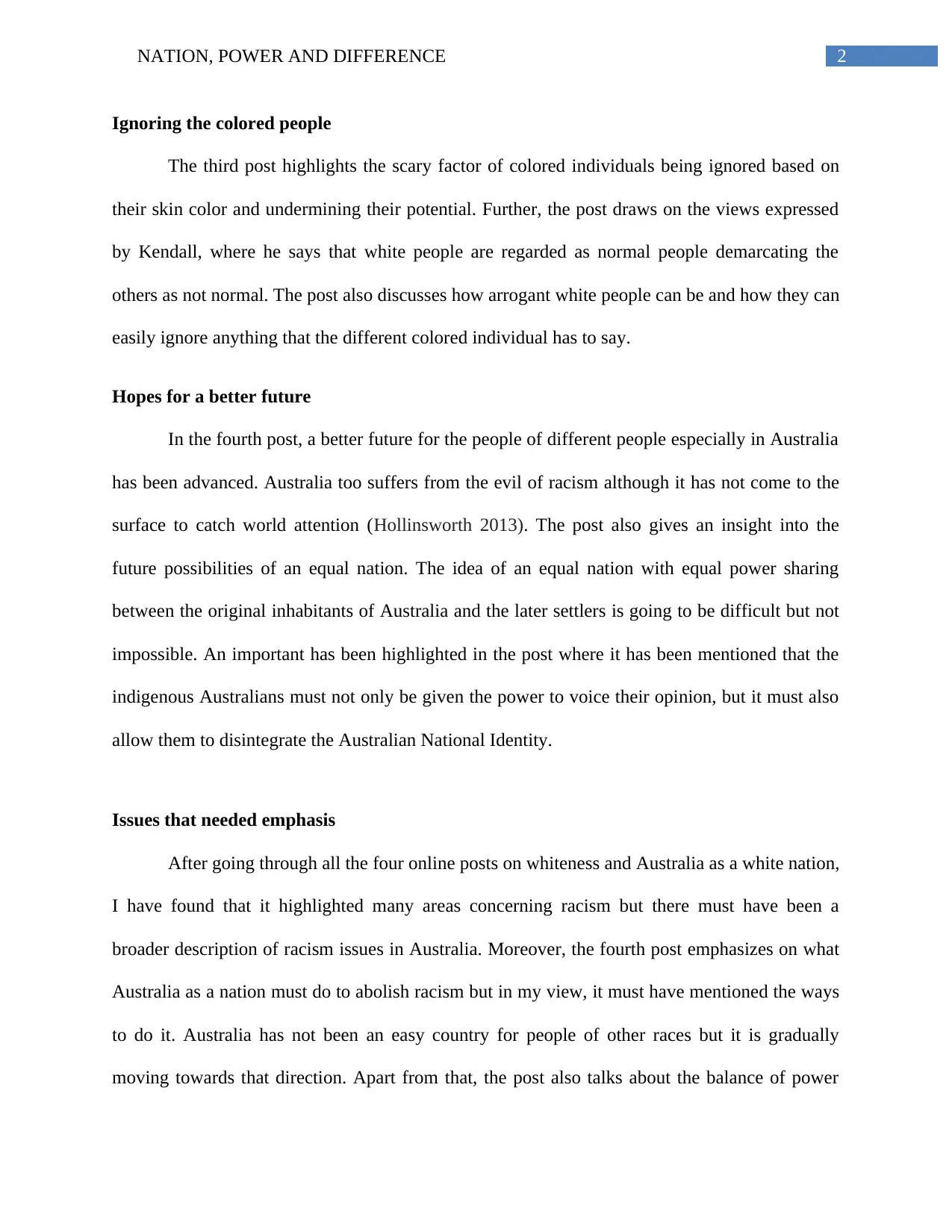
2NATION, POWER AND DIFFERENCE
Ignoring the colored people
The third post highlights the scary factor of colored individuals being ignored based on
their skin color and undermining their potential. Further, the post draws on the views expressed
by Kendall, where he says that white people are regarded as normal people demarcating the
others as not normal. The post also discusses how arrogant white people can be and how they can
easily ignore anything that the different colored individual has to say.
Hopes for a better future
In the fourth post, a better future for the people of different people especially in Australia
has been advanced. Australia too suffers from the evil of racism although it has not come to the
surface to catch world attention (Hollinsworth 2013). The post also gives an insight into the
future possibilities of an equal nation. The idea of an equal nation with equal power sharing
between the original inhabitants of Australia and the later settlers is going to be difficult but not
impossible. An important has been highlighted in the post where it has been mentioned that the
indigenous Australians must not only be given the power to voice their opinion, but it must also
allow them to disintegrate the Australian National Identity.
Issues that needed emphasis
After going through all the four online posts on whiteness and Australia as a white nation,
I have found that it highlighted many areas concerning racism but there must have been a
broader description of racism issues in Australia. Moreover, the fourth post emphasizes on what
Australia as a nation must do to abolish racism but in my view, it must have mentioned the ways
to do it. Australia has not been an easy country for people of other races but it is gradually
moving towards that direction. Apart from that, the post also talks about the balance of power
Ignoring the colored people
The third post highlights the scary factor of colored individuals being ignored based on
their skin color and undermining their potential. Further, the post draws on the views expressed
by Kendall, where he says that white people are regarded as normal people demarcating the
others as not normal. The post also discusses how arrogant white people can be and how they can
easily ignore anything that the different colored individual has to say.
Hopes for a better future
In the fourth post, a better future for the people of different people especially in Australia
has been advanced. Australia too suffers from the evil of racism although it has not come to the
surface to catch world attention (Hollinsworth 2013). The post also gives an insight into the
future possibilities of an equal nation. The idea of an equal nation with equal power sharing
between the original inhabitants of Australia and the later settlers is going to be difficult but not
impossible. An important has been highlighted in the post where it has been mentioned that the
indigenous Australians must not only be given the power to voice their opinion, but it must also
allow them to disintegrate the Australian National Identity.
Issues that needed emphasis
After going through all the four online posts on whiteness and Australia as a white nation,
I have found that it highlighted many areas concerning racism but there must have been a
broader description of racism issues in Australia. Moreover, the fourth post emphasizes on what
Australia as a nation must do to abolish racism but in my view, it must have mentioned the ways
to do it. Australia has not been an easy country for people of other races but it is gradually
moving towards that direction. Apart from that, the post also talks about the balance of power
⊘ This is a preview!⊘
Do you want full access?
Subscribe today to unlock all pages.

Trusted by 1+ million students worldwide
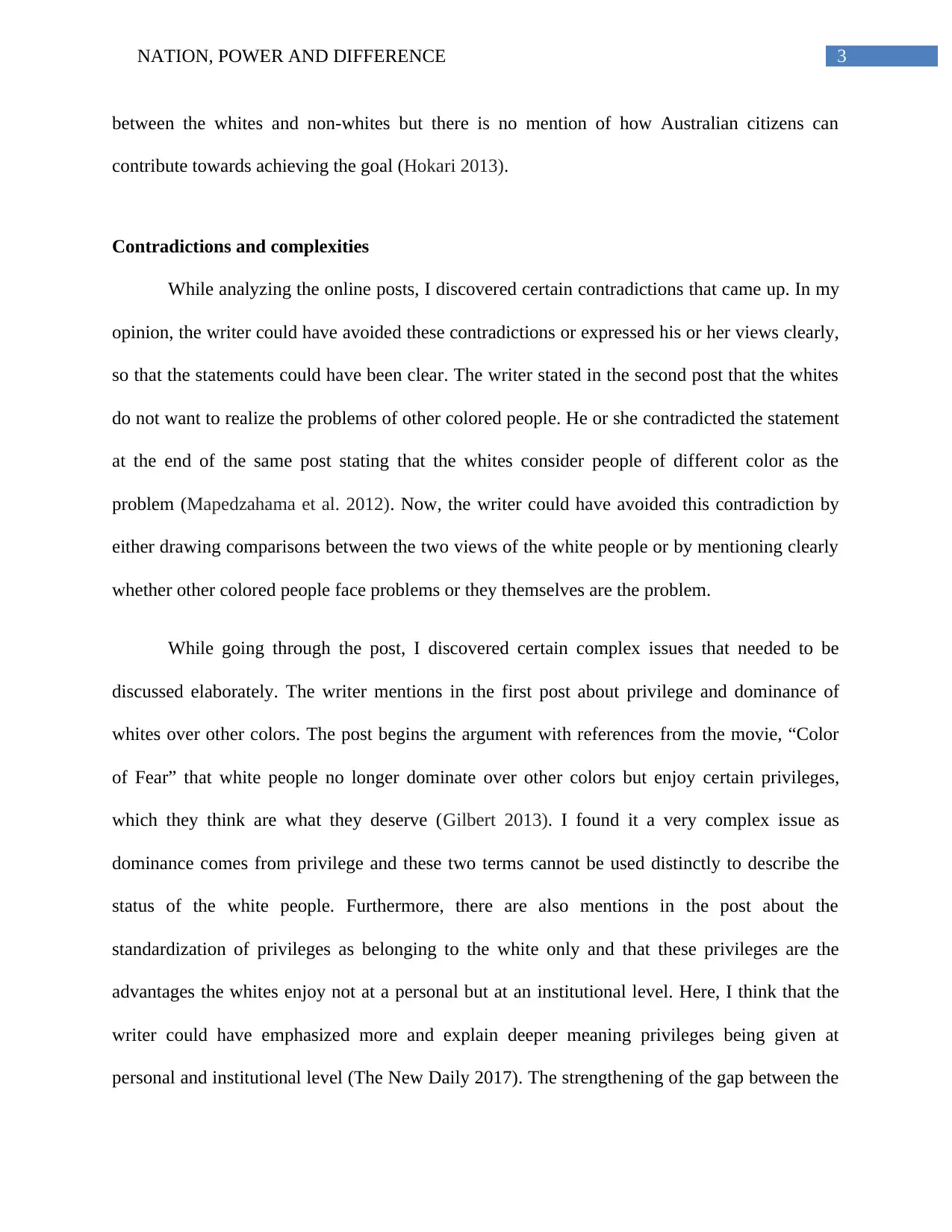
3NATION, POWER AND DIFFERENCE
between the whites and non-whites but there is no mention of how Australian citizens can
contribute towards achieving the goal (Hokari 2013).
Contradictions and complexities
While analyzing the online posts, I discovered certain contradictions that came up. In my
opinion, the writer could have avoided these contradictions or expressed his or her views clearly,
so that the statements could have been clear. The writer stated in the second post that the whites
do not want to realize the problems of other colored people. He or she contradicted the statement
at the end of the same post stating that the whites consider people of different color as the
problem (Mapedzahama et al. 2012). Now, the writer could have avoided this contradiction by
either drawing comparisons between the two views of the white people or by mentioning clearly
whether other colored people face problems or they themselves are the problem.
While going through the post, I discovered certain complex issues that needed to be
discussed elaborately. The writer mentions in the first post about privilege and dominance of
whites over other colors. The post begins the argument with references from the movie, “Color
of Fear” that white people no longer dominate over other colors but enjoy certain privileges,
which they think are what they deserve (Gilbert 2013). I found it a very complex issue as
dominance comes from privilege and these two terms cannot be used distinctly to describe the
status of the white people. Furthermore, there are also mentions in the post about the
standardization of privileges as belonging to the white only and that these privileges are the
advantages the whites enjoy not at a personal but at an institutional level. Here, I think that the
writer could have emphasized more and explain deeper meaning privileges being given at
personal and institutional level (The New Daily 2017). The strengthening of the gap between the
between the whites and non-whites but there is no mention of how Australian citizens can
contribute towards achieving the goal (Hokari 2013).
Contradictions and complexities
While analyzing the online posts, I discovered certain contradictions that came up. In my
opinion, the writer could have avoided these contradictions or expressed his or her views clearly,
so that the statements could have been clear. The writer stated in the second post that the whites
do not want to realize the problems of other colored people. He or she contradicted the statement
at the end of the same post stating that the whites consider people of different color as the
problem (Mapedzahama et al. 2012). Now, the writer could have avoided this contradiction by
either drawing comparisons between the two views of the white people or by mentioning clearly
whether other colored people face problems or they themselves are the problem.
While going through the post, I discovered certain complex issues that needed to be
discussed elaborately. The writer mentions in the first post about privilege and dominance of
whites over other colors. The post begins the argument with references from the movie, “Color
of Fear” that white people no longer dominate over other colors but enjoy certain privileges,
which they think are what they deserve (Gilbert 2013). I found it a very complex issue as
dominance comes from privilege and these two terms cannot be used distinctly to describe the
status of the white people. Furthermore, there are also mentions in the post about the
standardization of privileges as belonging to the white only and that these privileges are the
advantages the whites enjoy not at a personal but at an institutional level. Here, I think that the
writer could have emphasized more and explain deeper meaning privileges being given at
personal and institutional level (The New Daily 2017). The strengthening of the gap between the
Paraphrase This Document
Need a fresh take? Get an instant paraphrase of this document with our AI Paraphraser

4NATION, POWER AND DIFFERENCE
privileged and the neglected with each passing time is getting stronger to an extent that white
people find privileges to be normal, mentions the writer. I found this to be another complex
issue. According to me, the writer could have used case studies to prove this point as I found it
difficult as a reader to affirm to this point. It is because there are evidences that the world is
moving ahead and there have been events and incidents that confirmed the fact that racism today
is in its weakest form (Herring et al. 2013).
Links to nation, power and difference concepts
When I went through the fourth online post that mentioned the status and stand of
Australia in regards of racism, I found minimum references to the concepts of nation, power and
difference. Australia as a nation has faced the wrath of racism more than any other country
especially during its initial years of existence but there was no mention about it in the post. In my
opinion, the post could have included examples from Australia’s history as a white nation where
policies like the White Australia Policy of 1901 boasted of white supremacy. Then it could have
stated how these policies were later amended (Australia.gov.au 2017). In addition to that, I think
the writer could also have highlighted the present status of the country. The amendments in laws,
declaring Australia as a rapidly developing multicultural nation, could also have helped give the
readers a clear view of the writer (ABC News 2017).
Those enjoying privileges automatically earn the ability to enjoy power. The concept of
power according to me, thus, is directly related to privileges. The post I feel could have
established a link between these concepts. However, the last section of the fourth post does
mention about the sharing of power and the need for it to be the focus of Australia as a nation
looking ahead. Still, I as a reader craved for more insights into the steps taken by Australia in this
privileged and the neglected with each passing time is getting stronger to an extent that white
people find privileges to be normal, mentions the writer. I found this to be another complex
issue. According to me, the writer could have used case studies to prove this point as I found it
difficult as a reader to affirm to this point. It is because there are evidences that the world is
moving ahead and there have been events and incidents that confirmed the fact that racism today
is in its weakest form (Herring et al. 2013).
Links to nation, power and difference concepts
When I went through the fourth online post that mentioned the status and stand of
Australia in regards of racism, I found minimum references to the concepts of nation, power and
difference. Australia as a nation has faced the wrath of racism more than any other country
especially during its initial years of existence but there was no mention about it in the post. In my
opinion, the post could have included examples from Australia’s history as a white nation where
policies like the White Australia Policy of 1901 boasted of white supremacy. Then it could have
stated how these policies were later amended (Australia.gov.au 2017). In addition to that, I think
the writer could also have highlighted the present status of the country. The amendments in laws,
declaring Australia as a rapidly developing multicultural nation, could also have helped give the
readers a clear view of the writer (ABC News 2017).
Those enjoying privileges automatically earn the ability to enjoy power. The concept of
power according to me, thus, is directly related to privileges. The post I feel could have
established a link between these concepts. However, the last section of the fourth post does
mention about the sharing of power and the need for it to be the focus of Australia as a nation
looking ahead. Still, I as a reader craved for more insights into the steps taken by Australia in this
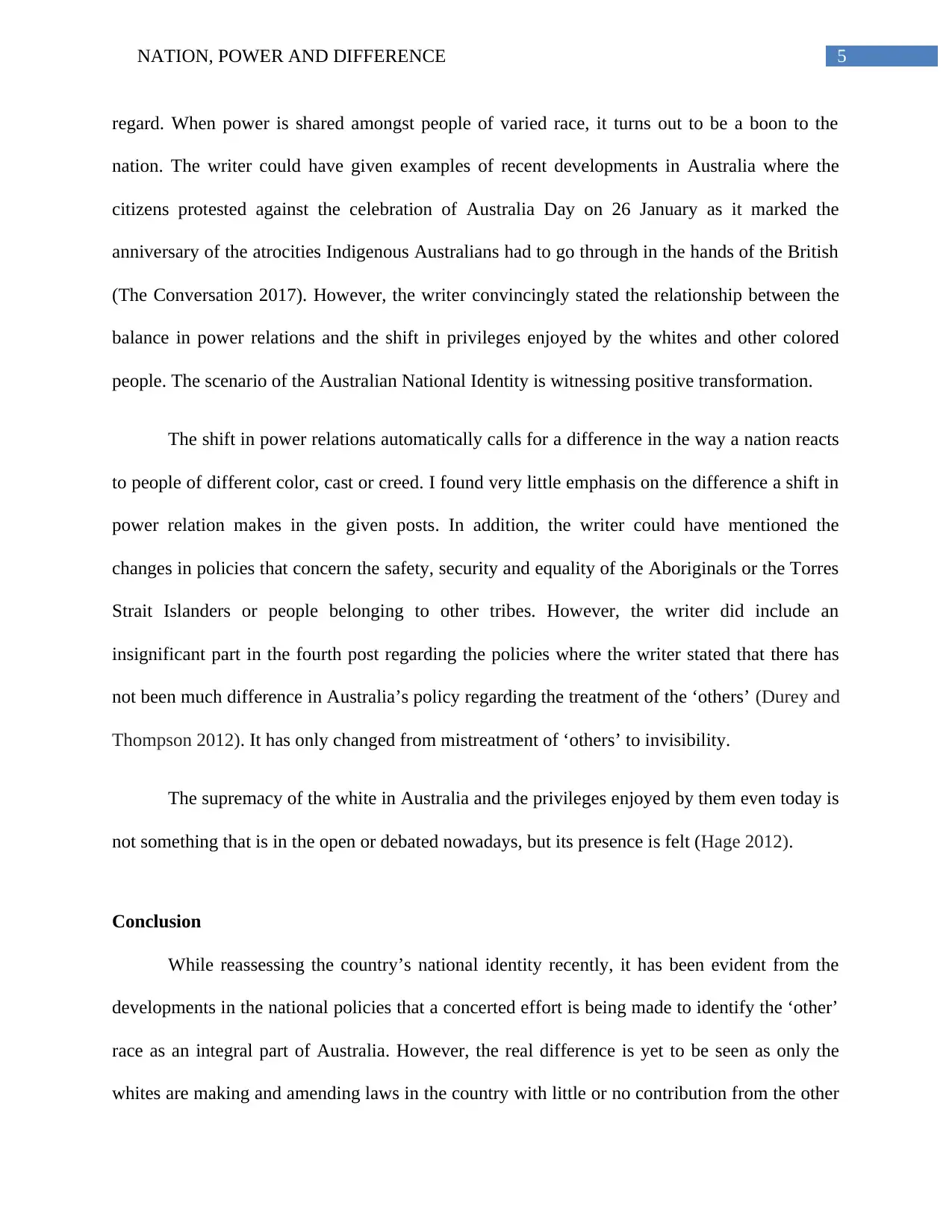
5NATION, POWER AND DIFFERENCE
regard. When power is shared amongst people of varied race, it turns out to be a boon to the
nation. The writer could have given examples of recent developments in Australia where the
citizens protested against the celebration of Australia Day on 26 January as it marked the
anniversary of the atrocities Indigenous Australians had to go through in the hands of the British
(The Conversation 2017). However, the writer convincingly stated the relationship between the
balance in power relations and the shift in privileges enjoyed by the whites and other colored
people. The scenario of the Australian National Identity is witnessing positive transformation.
The shift in power relations automatically calls for a difference in the way a nation reacts
to people of different color, cast or creed. I found very little emphasis on the difference a shift in
power relation makes in the given posts. In addition, the writer could have mentioned the
changes in policies that concern the safety, security and equality of the Aboriginals or the Torres
Strait Islanders or people belonging to other tribes. However, the writer did include an
insignificant part in the fourth post regarding the policies where the writer stated that there has
not been much difference in Australia’s policy regarding the treatment of the ‘others’ (Durey and
Thompson 2012). It has only changed from mistreatment of ‘others’ to invisibility.
The supremacy of the white in Australia and the privileges enjoyed by them even today is
not something that is in the open or debated nowadays, but its presence is felt (Hage 2012).
Conclusion
While reassessing the country’s national identity recently, it has been evident from the
developments in the national policies that a concerted effort is being made to identify the ‘other’
race as an integral part of Australia. However, the real difference is yet to be seen as only the
whites are making and amending laws in the country with little or no contribution from the other
regard. When power is shared amongst people of varied race, it turns out to be a boon to the
nation. The writer could have given examples of recent developments in Australia where the
citizens protested against the celebration of Australia Day on 26 January as it marked the
anniversary of the atrocities Indigenous Australians had to go through in the hands of the British
(The Conversation 2017). However, the writer convincingly stated the relationship between the
balance in power relations and the shift in privileges enjoyed by the whites and other colored
people. The scenario of the Australian National Identity is witnessing positive transformation.
The shift in power relations automatically calls for a difference in the way a nation reacts
to people of different color, cast or creed. I found very little emphasis on the difference a shift in
power relation makes in the given posts. In addition, the writer could have mentioned the
changes in policies that concern the safety, security and equality of the Aboriginals or the Torres
Strait Islanders or people belonging to other tribes. However, the writer did include an
insignificant part in the fourth post regarding the policies where the writer stated that there has
not been much difference in Australia’s policy regarding the treatment of the ‘others’ (Durey and
Thompson 2012). It has only changed from mistreatment of ‘others’ to invisibility.
The supremacy of the white in Australia and the privileges enjoyed by them even today is
not something that is in the open or debated nowadays, but its presence is felt (Hage 2012).
Conclusion
While reassessing the country’s national identity recently, it has been evident from the
developments in the national policies that a concerted effort is being made to identify the ‘other’
race as an integral part of Australia. However, the real difference is yet to be seen as only the
whites are making and amending laws in the country with little or no contribution from the other
⊘ This is a preview!⊘
Do you want full access?
Subscribe today to unlock all pages.

Trusted by 1+ million students worldwide
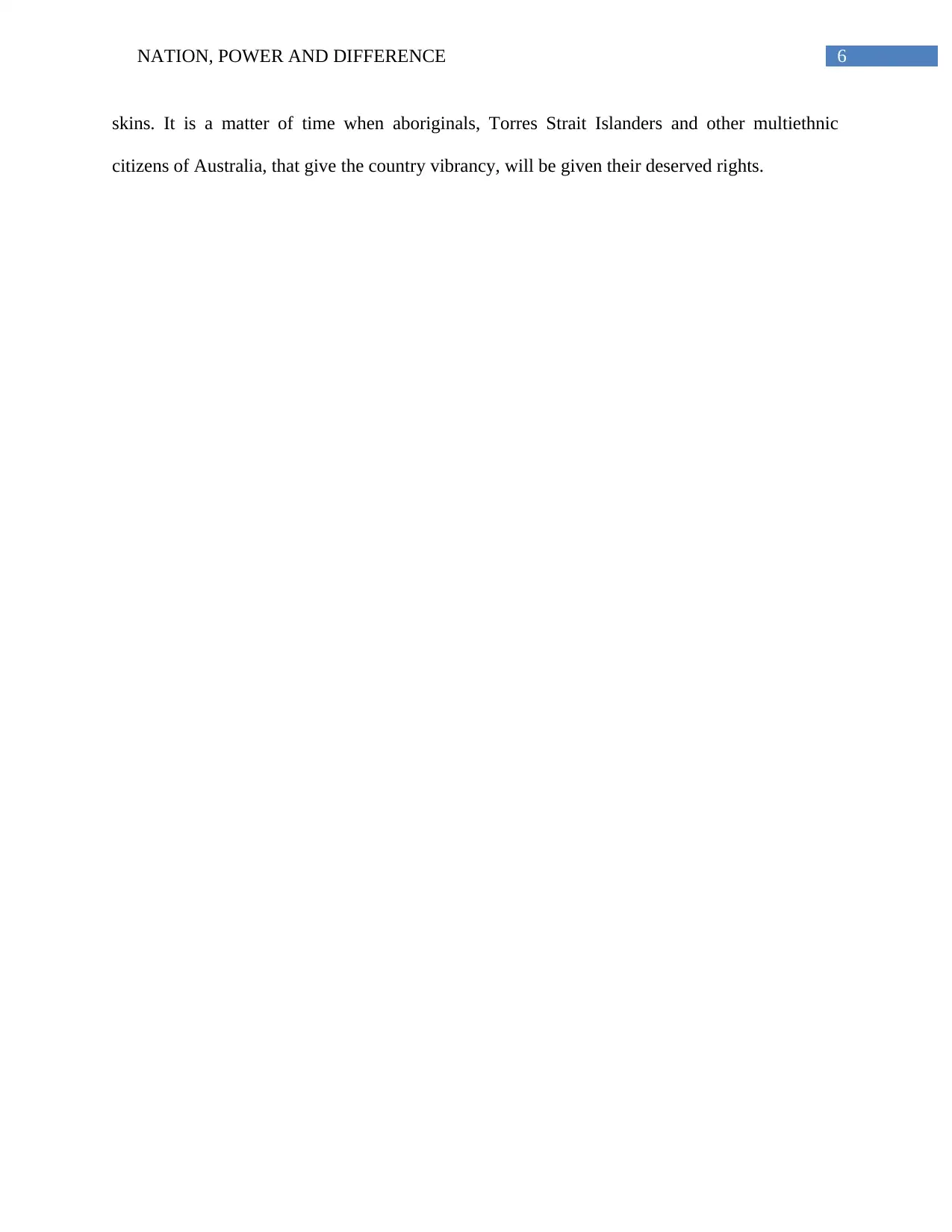
6NATION, POWER AND DIFFERENCE
skins. It is a matter of time when aboriginals, Torres Strait Islanders and other multiethnic
citizens of Australia, that give the country vibrancy, will be given their deserved rights.
skins. It is a matter of time when aboriginals, Torres Strait Islanders and other multiethnic
citizens of Australia, that give the country vibrancy, will be given their deserved rights.
Paraphrase This Document
Need a fresh take? Get an instant paraphrase of this document with our AI Paraphraser
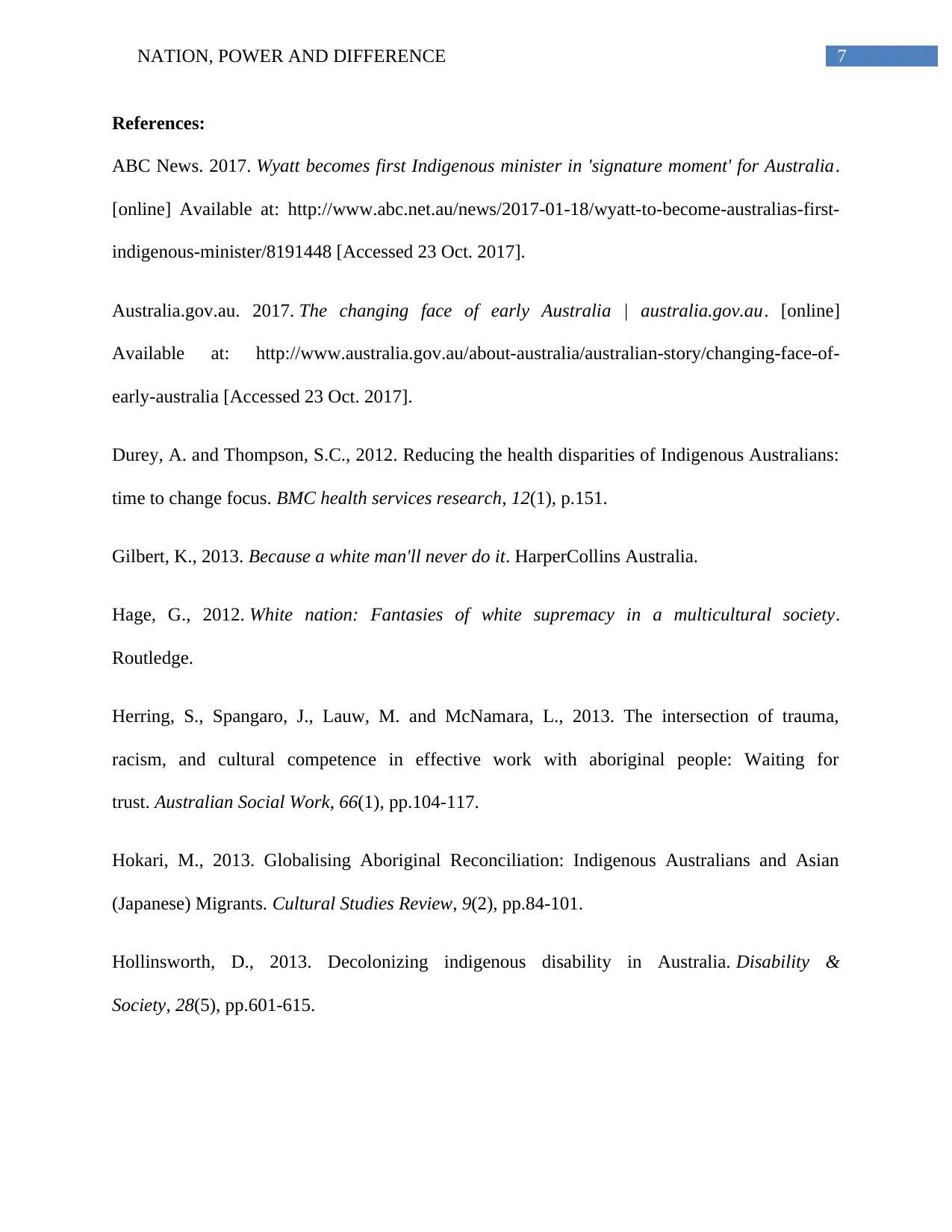
7NATION, POWER AND DIFFERENCE
References:
ABC News. 2017. Wyatt becomes first Indigenous minister in 'signature moment' for Australia.
[online] Available at: http://www.abc.net.au/news/2017-01-18/wyatt-to-become-australias-first-
indigenous-minister/8191448 [Accessed 23 Oct. 2017].
Australia.gov.au. 2017. The changing face of early Australia | australia.gov.au. [online]
Available at: http://www.australia.gov.au/about-australia/australian-story/changing-face-of-
early-australia [Accessed 23 Oct. 2017].
Durey, A. and Thompson, S.C., 2012. Reducing the health disparities of Indigenous Australians:
time to change focus. BMC health services research, 12(1), p.151.
Gilbert, K., 2013. Because a white man'll never do it. HarperCollins Australia.
Hage, G., 2012. White nation: Fantasies of white supremacy in a multicultural society.
Routledge.
Herring, S., Spangaro, J., Lauw, M. and McNamara, L., 2013. The intersection of trauma,
racism, and cultural competence in effective work with aboriginal people: Waiting for
trust. Australian Social Work, 66(1), pp.104-117.
Hokari, M., 2013. Globalising Aboriginal Reconciliation: Indigenous Australians and Asian
(Japanese) Migrants. Cultural Studies Review, 9(2), pp.84-101.
Hollinsworth, D., 2013. Decolonizing indigenous disability in Australia. Disability &
Society, 28(5), pp.601-615.
References:
ABC News. 2017. Wyatt becomes first Indigenous minister in 'signature moment' for Australia.
[online] Available at: http://www.abc.net.au/news/2017-01-18/wyatt-to-become-australias-first-
indigenous-minister/8191448 [Accessed 23 Oct. 2017].
Australia.gov.au. 2017. The changing face of early Australia | australia.gov.au. [online]
Available at: http://www.australia.gov.au/about-australia/australian-story/changing-face-of-
early-australia [Accessed 23 Oct. 2017].
Durey, A. and Thompson, S.C., 2012. Reducing the health disparities of Indigenous Australians:
time to change focus. BMC health services research, 12(1), p.151.
Gilbert, K., 2013. Because a white man'll never do it. HarperCollins Australia.
Hage, G., 2012. White nation: Fantasies of white supremacy in a multicultural society.
Routledge.
Herring, S., Spangaro, J., Lauw, M. and McNamara, L., 2013. The intersection of trauma,
racism, and cultural competence in effective work with aboriginal people: Waiting for
trust. Australian Social Work, 66(1), pp.104-117.
Hokari, M., 2013. Globalising Aboriginal Reconciliation: Indigenous Australians and Asian
(Japanese) Migrants. Cultural Studies Review, 9(2), pp.84-101.
Hollinsworth, D., 2013. Decolonizing indigenous disability in Australia. Disability &
Society, 28(5), pp.601-615.
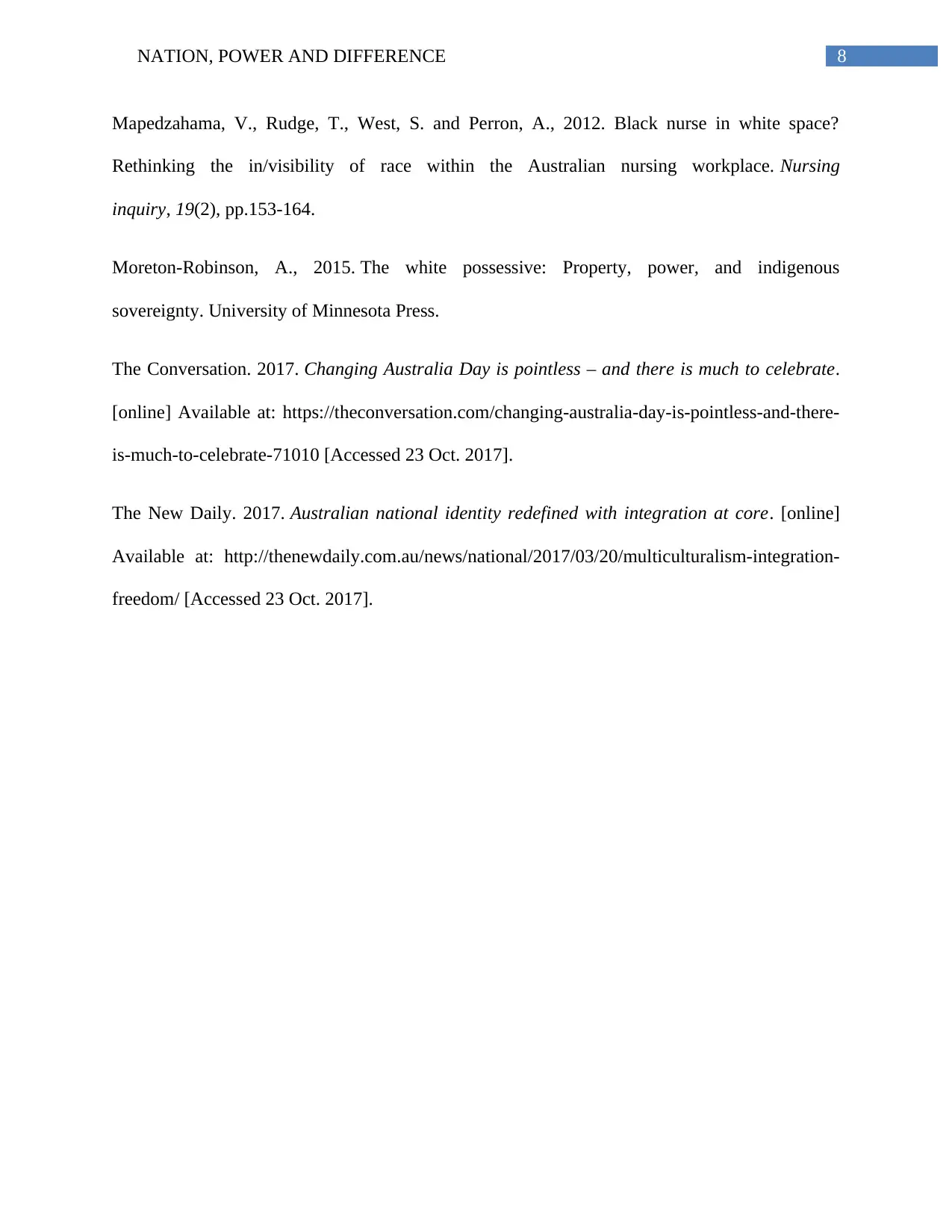
8NATION, POWER AND DIFFERENCE
Mapedzahama, V., Rudge, T., West, S. and Perron, A., 2012. Black nurse in white space?
Rethinking the in/visibility of race within the Australian nursing workplace. Nursing
inquiry, 19(2), pp.153-164.
Moreton-Robinson, A., 2015. The white possessive: Property, power, and indigenous
sovereignty. University of Minnesota Press.
The Conversation. 2017. Changing Australia Day is pointless – and there is much to celebrate.
[online] Available at: https://theconversation.com/changing-australia-day-is-pointless-and-there-
is-much-to-celebrate-71010 [Accessed 23 Oct. 2017].
The New Daily. 2017. Australian national identity redefined with integration at core. [online]
Available at: http://thenewdaily.com.au/news/national/2017/03/20/multiculturalism-integration-
freedom/ [Accessed 23 Oct. 2017].
Mapedzahama, V., Rudge, T., West, S. and Perron, A., 2012. Black nurse in white space?
Rethinking the in/visibility of race within the Australian nursing workplace. Nursing
inquiry, 19(2), pp.153-164.
Moreton-Robinson, A., 2015. The white possessive: Property, power, and indigenous
sovereignty. University of Minnesota Press.
The Conversation. 2017. Changing Australia Day is pointless – and there is much to celebrate.
[online] Available at: https://theconversation.com/changing-australia-day-is-pointless-and-there-
is-much-to-celebrate-71010 [Accessed 23 Oct. 2017].
The New Daily. 2017. Australian national identity redefined with integration at core. [online]
Available at: http://thenewdaily.com.au/news/national/2017/03/20/multiculturalism-integration-
freedom/ [Accessed 23 Oct. 2017].
⊘ This is a preview!⊘
Do you want full access?
Subscribe today to unlock all pages.

Trusted by 1+ million students worldwide
1 out of 9
Related Documents
Your All-in-One AI-Powered Toolkit for Academic Success.
+13062052269
info@desklib.com
Available 24*7 on WhatsApp / Email
![[object Object]](/_next/static/media/star-bottom.7253800d.svg)
Unlock your academic potential
Copyright © 2020–2025 A2Z Services. All Rights Reserved. Developed and managed by ZUCOL.





